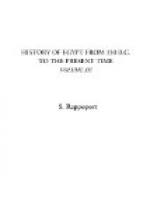This chamber was
burnt; and is apparently that mentioned by
M. Amelineau, Fouilles,
in extenso, 1899, page 107.
The tomb B 19, which contained the best tablet of Aha-Mena, is probably his tomb; for the tomb with his vases at Naqada is more probably that of his queen Neithotep. As both the tombs B 17 and 18 to the north of this contained objects of Mena, it is probable that they were the tombs of some members of his family.
The great cemetery of the domestics of this age is the triple row of tombs to the east of the royal tombs; in all the thirty-four tombs here, no name was found beside that of Aha on the jar sealings, and the two tombs, B 6 and B 14, seen to be probably of the same age. In B 14 were found only objects of Aha, and three of them were inscribed with the name of Bener-eb, probably the name of a wife or a daughter of Mena, which is not found in any other tomb.*
* Professor Petrie’s arguments, although home out by the evidence that he produces, have from time to time been criticised. M. Naville, for example, endeavours to prove that the buildings in the desert are not literally tombs, but rather temples for the cult of their Ka; and that there ought not to be kings anterior to Mena, particularly at Abydos: “Narmer” is really Boethos, the first king of the second dynasty. According to M. Naville, Boethos, Usaphis, and Miebidos are the only kings as yet identified of the early time. M. Naville also suggests that Ka-Sekhem and Ka- Sekhemui are two names for one king.
[Illustration: 366.jpg EBONY TABLET OF KING AHA-MENA]
From the time of Mena has come down to us an ebony tablet, as shown in the illustration. This is the most complete of the inscriptions of this king, and was found in two portions in the tombs marked B 18 and B 19. The signs upon the tablet are most interesting. On the top line, after the cartouche of Aha-Mena, there are two sacred boats, probably of Sokaris, and a shrine and temenos of Nit. In the line below is seen a man making an offering, and behind him is a bull running over undulating ground into a net stretched between two poles, while at the end, standing upon a shrine, is a bird, which appears to be the ibis of Thot. A third line shows three boats upon a canal or river, passing between certain places, and it has been reasonably conjectured that




